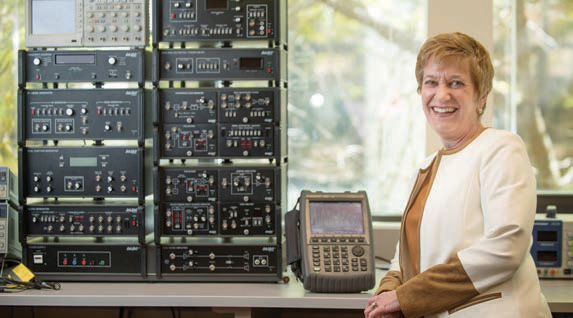One night, back in 1970, Gail Heck-Sweeney (’74) traveled with high school classmates to Havre, Montana for a “career night.” A gentleman stood in front of the group.
“Raise your hand if you’ve taken two years of math,” he said. Most students raised a hand. “Keep it up if you’ve had three years of math,” he continued. Several hands dropped. “Four?” Still more hands went down. By the time he asked who’d also taken chemistry, only Gail’s hand remained in the air. Afterwards, the gentleman approached Gail and asked if she’d ever considered engineering.
“You mean drive a train?” she exclaimed. The man then encouraged her to consider a career as the other sort of engineer. He gave her materials about Gonzaga’s School of Engineering and Applied Science. Until that moment, Gail had always thought she’d become a teacher, perhaps in physical education, typing or history, though she much preferred helping her father on the farm to staying inside or at a desk. That career night in Havre became a major turning point in determining Gail’s future.
She walked into her first class at GU and found herself in a room full of male students and only one other woman, who was sitting in the front row.
“It was a little intimidating at first,” she recalled. Gail quickly turned the gender disproportion to her advantage. “I’d cut the other engineers’ hair to get spending money,” she explained. “At that time, there were many international students who weren’t familiar with the area, so I was their barber.”
Gonzaga’s Engineering Program expanded Gail’s world beyond the bounds of Montana. Her liberal arts education, in addition to her technical engineering studies, provided her an appreciation for the great diversity in the world. Additionally, she found opportunities to volunteer and serve through her involvement in Spurs and as a resident assistant and director; she built lifelong friendships with her classmates and professors, and discovered a confidence that truly opened doors.
“I soon realized I could do anything I wanted,” she said. “I came here having never been on an airplane, I’d never seen anyone from China, India or Japan. By my senior year, I didn’t even have to sign up for interviews—companies were coming to me.”
Since graduating from Gonzaga with her degree that had an emphasis in environmental and engineering sciences, Gail earned her MBA from Santa Clara University and spent the majority of her career outside of the United States, working hard to become a leader in engineering and in management. Her experience managing a staff in China inspired her to pursue life coaching.
“They expected a great deal of management,” she explained. “My role was very involved with their lives as well as their growth in the company. They’d ask, ‘what is the purpose of my life?’ I just wished I could send them all to Gonzaga for four years!”
Gail now works for Keysight Technologies, a company that builds test equipment used on radios, mobile phone components, and drug tests for the Olympics, genetic testing and more—even Greenwich Mean Time is kept accurate using their equipment. One thing that has managed to pass the test every time, is Gail’s strong, continued connection to Gonzaga.
“I’ve kept up with my engineering class and groups of friends. I see notes from advisory boards in the School Engineering and Applied Science and the School of Business,” she said. “Father Spitzer was in my class.”

Looking to the future, Gail sees much of what she received from her own Gonzaga experience as central to the success of tomorrow’s engineers.
“Gonzaga always put the emphasis on the students,” she recalled, “and that’s going to be critical moving forward.” She also has high hopes for growth in the STEM fields. Gail also has a vision for continued, improved diversity—particularly with respect to women in the field of engineering.
“There are more women in engineering now compared to when I was in school,” she said. “I think it’s something we can work on in our culture, keeping these paths open, letting girls know engineering is an option and encouraging them to explore it.”
